25+ SAMPLE Construction Request for Proposal
-
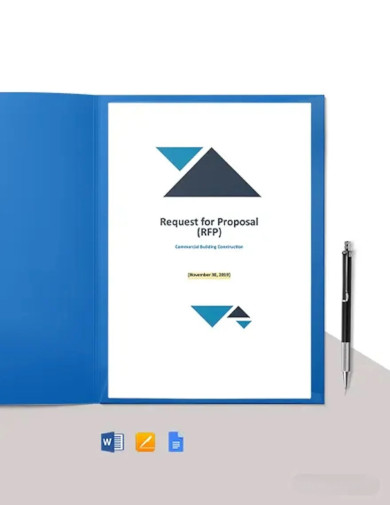
Construction Request for Proposal
download now -
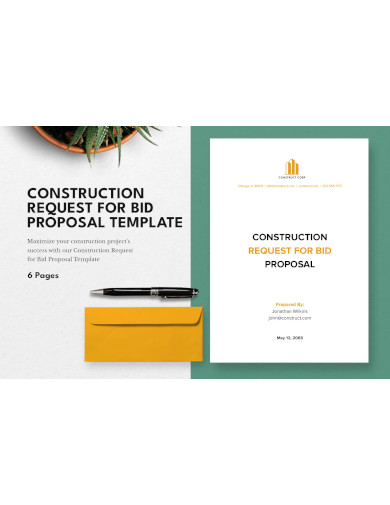
Construction Request for Bid Proposal
download now -
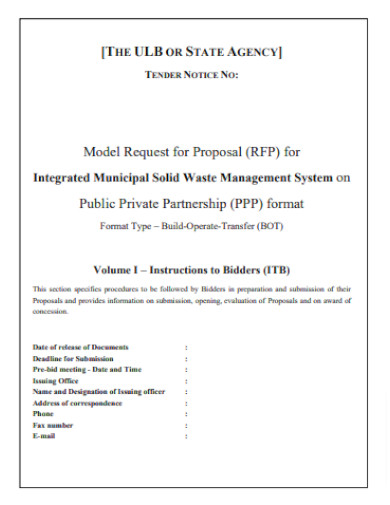
Construction Partnership Request Proposal
download now -
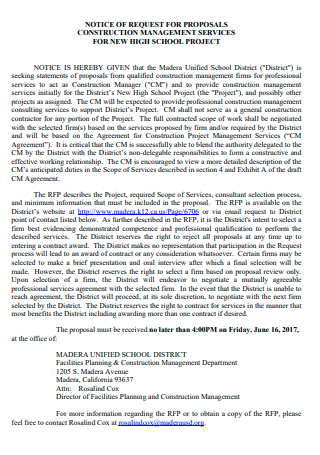
High School Project Construction Management Services Request For Proposal
download now -
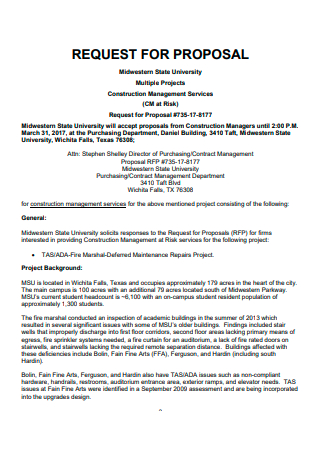
Multiple Project Construction Management Request For Proposal
download now -

General Construction Contractor Request For Proposal
download now -
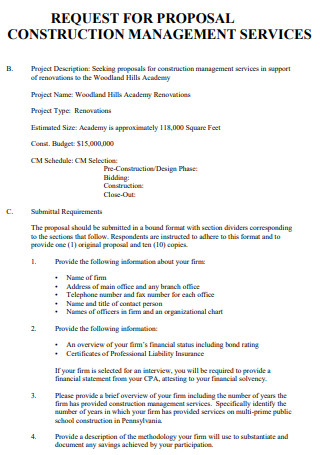
Construction Services Request for Proposal
download now -
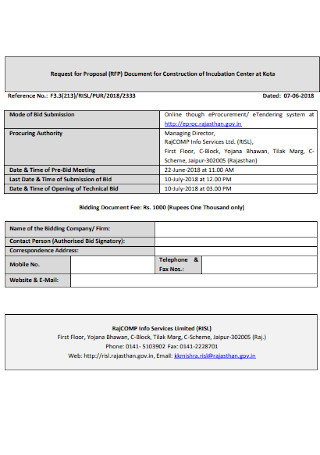
Request for Proposal Document for Construction
download now -
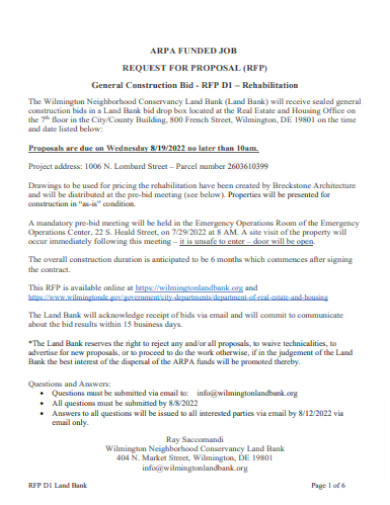
Construction Bid Request Proposal
download now -
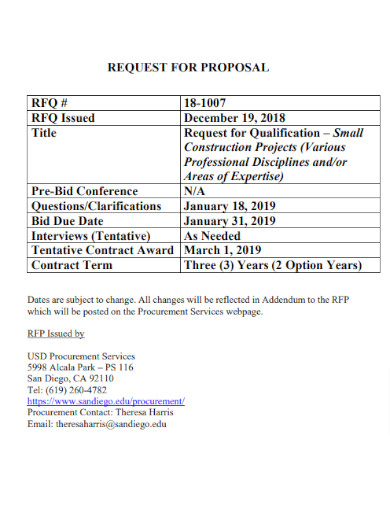
Simple Construction Request Proposal
download now -
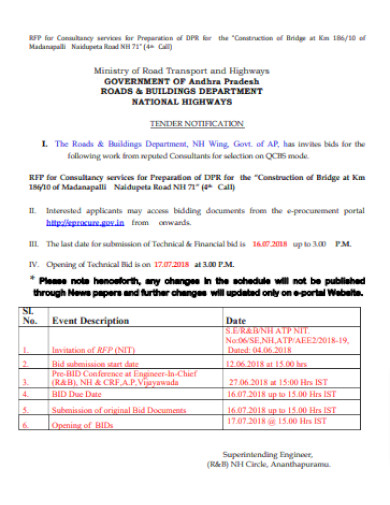
Printable Construction Request Proposal
download now -

Development Construction Request Proposal
download now -

Request Proposal for Construction Services
download now -
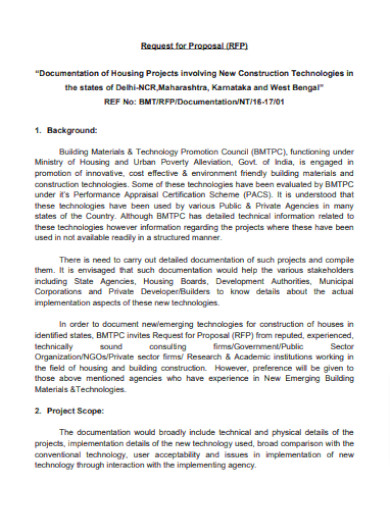
Sample Construction Request Proposal
download now -
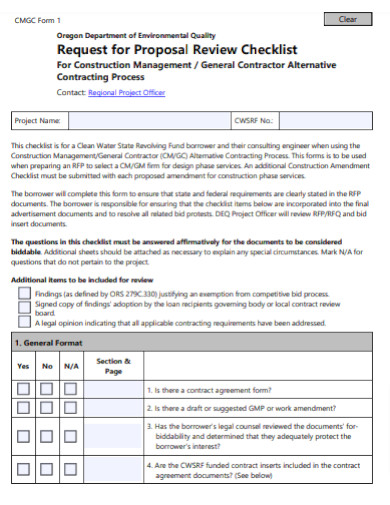
Construction Request Proposal Review Checklist
download now -
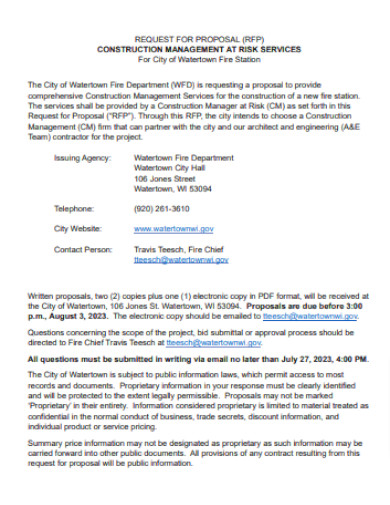
Construction Management Request Proposal
download now -
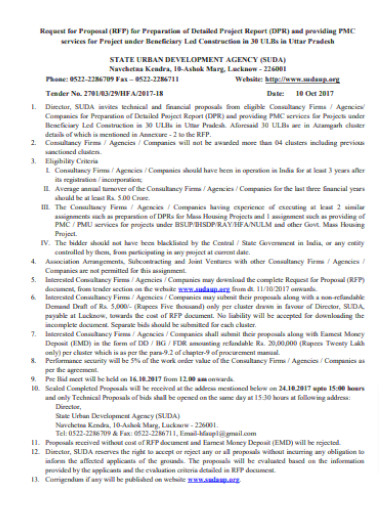
Basic Construction Request Proposal
download now -
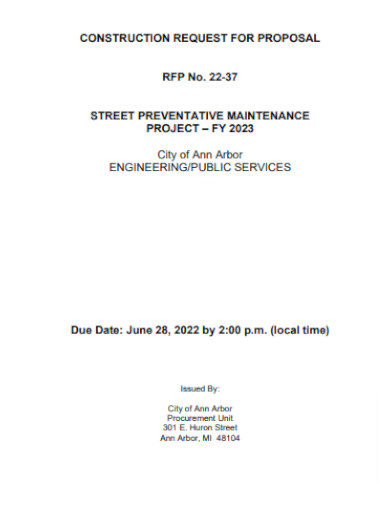
Construction Request Proposal Outline
download now -

Construction Online Request Proposal
download now -
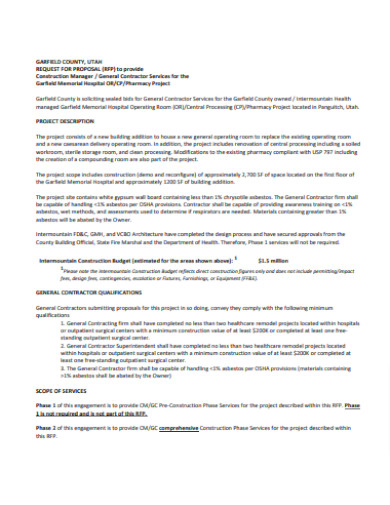
Construction Request Proposal Layout
download now -
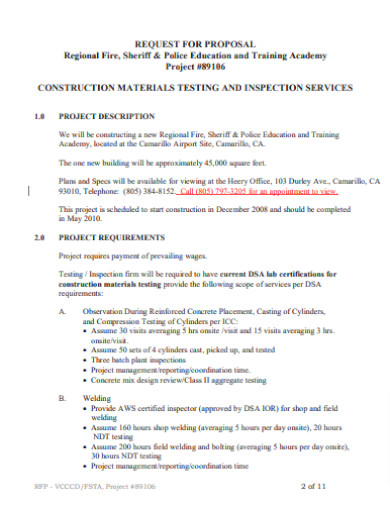
Standard Construction Request Proposal
download now -

Construction Request Manager Proposal
download now -
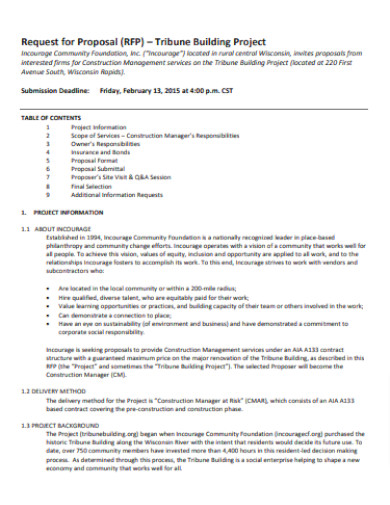
Construction Request Project Proposal
download now -

Construction Request Proposal Format
download now -
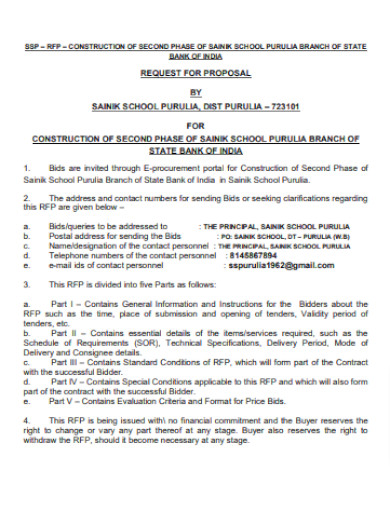
Construction Request Contractor Proposal
download now -
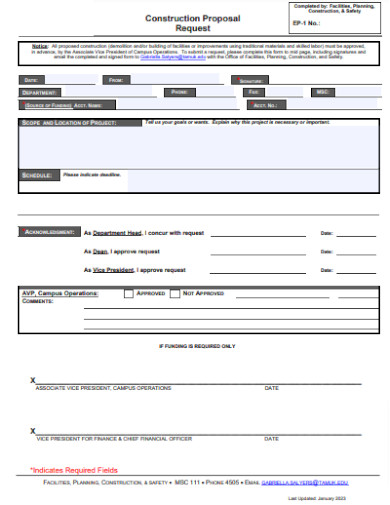
Construction Request Proposal Form
download now
FREE Construction Request for Proposal s to Download
25+ SAMPLE Construction Request for Proposal
Definition:
Bridging Visions with Expertise:
The Essence and Role of a Construction RFP:
Key Ingredients of a Robust RFP:
Crafting a Successful RFP Response:
Decoding and Leveraging Feedback:
Why is an RFP vital for detailed construction projects?
Would proposals submitted by Joint Ventures be acceptable?
Can clients request specific subcontractors in an RFP?
How can contractors address potential risks in their RFP responses?
What essential sections should a construction RFP include?
How can clients evaluate contractors’ responses to an RFP effectively?
Definition:
A Construction Request for Proposal (RFP) is a formal document issued by a client or organization seeking detailed proposals from contractors for a specific construction project. It outlines project requirements, desired outcomes, evaluation criteria, and other pertinent details, allowing contractors to provide comprehensive bids that address the client’s specific needs and objectives.
Bridging Visions with Expertise:
In the intricate tapestry of the construction landscape, the stitching of conceptual dreams to tangible outcomes is no small feat. At the heart of this transformative journey lies the Construction Request for Proposal (RFP). This pivotal tool serves as a beacon, drawing in skilled contractors and firms to interpret, bid, and execute a project’s vision. Through an RFP, project owners broadcast their aspirations, while potential collaborators showcase their competencies, ensuring that the final output resonates with quality, efficiency, and innovation.
The Essence and Role of a Construction RFP:
At its core, a Construction Request for Proposal (RFP) serves as a bridge between a client’s vision and the tangible means to realize it. Acting as a catalyst for informed decision-making, the RFP sets in motion the process of turning conceptual ideas into on-ground structures.
Essence of a Construction RFP:
- Clarity and Definition: By detailing out the specific needs, requirements, and expectations, an RFP provides a clear roadmap for potential bidders to follow.
- Standardization: It ensures that all prospective bidders are on the same page, paving the way for uniform, comparable submissions.
Role of a Construction RFP:
- Facilitator of Proposals: The RFP serves as an open invitation for skilled contractors to showcase their capabilities and vision, leading to a pool of competitive bids.
- Risk Minimizer: With detailed specifications and criteria, it reduces ambiguities, limiting the scope for misinterpretations or disputes down the line.
- Tool for Selection: A well-crafted RFP provides a systematic framework for evaluating and comparing bids, ensuring that the chosen contractor aligns well with the project’s demands.
- Budgetary Guide: By elucidating financial constraints or targets, the RFP helps potential bidders create financially viable proposals.
- Time Management: With clear timelines for submission, evaluation, and project commencement, an RFP ensures adherence to schedules, preventing potential delays.
- Legal Safeguard: Apart from the technical and operational facets, RFPs often include legal stipulations that set the terms of engagement, protecting the interests of all parties involved.
Key Ingredients of a Robust RFP:
Crafting a robust Construction Request for Proposal (RFP) requires a blend of clarity, detail, and foresight. Here are the key ingredients that elevate an RFP from mere documentation to a potent tool for solicitation:
Project Overview:
Begin with a concise summary that captures the essence of the project. Whether it’s a residential building, commercial complex, or an infrastructure project, paint a clear picture of the scope and objective.
Detailed Specifications:
Dive deep into the specifics. This could include architectural plans, site conditions, material preferences, and any unique features or requirements. The more detailed this section, the more aligned the bids will be to the project’s needs.
Budget Constraints:
Transparency about the available budget or financial expectations is crucial. It ensures that contractors can tailor their solutions without overshooting cost limits.
Timeline Expectations:
Clearly outline the project milestones, from groundbreaking to completion. This assists contractors in gauging feasibility and aligning their resources.
Evaluation Criteria:
Define the parameters against which the proposals will be assessed. Whether it’s cost, experience, innovative solutions, or a combination of factors, knowing these criteria can help bidders tailor their responses.
Submission Requirements:
Provide clear instructions about the desired format, supporting documents, and any other essentials required for the bid. This ensures uniformity and simplifies the review process.
Legal and Contractual Stipulations:
Address aspects like warranties, liabilities, insurance requirements, and any penalties for delays or non-compliance. By laying out these terms, you ensure both parties understand their obligations.
Communication Protocols:
Specify the points of contact, methods for seeking clarifications, and any scheduled Q&A sessions or site visits. Streamlined communication can eliminate ambiguities and foster better understanding.
Response Deadline:
Clearly indicate the closing date and time for proposal submission. This ensures timely responses and sets the pace for the next steps in the selection process.
Confidentiality Agreements:
If there’s sensitive information involved, it’s crucial to include non-disclosure agreements or confidentiality clauses, safeguarding the project’s details.
Feedback Mechanism:
Consider providing a structure or timeline for giving feedback to the bidders, ensuring transparency and fostering trust.
Crafting a Successful RFP Response:
Crafting a successful RFP response for a construction project requires a blend of precision, strategy, and showcasing capabilities. Here’s a guide to ensuring your proposal stands out:
Understand the Project:
Before delving into the response, thoroughly read and understand the RFP. Grasping the project’s nuances, objectives, and requirements is the first step towards crafting a compelling proposal.
Tailor Your Response:
Avoid generic or boilerplate answers. Each RFP is unique, and your response should be tailored to the specific project, demonstrating a keen understanding and alignment with its goals.
Highlight Relevant Experience:
Showcase past projects that resonate with the current RFP’s requirements. Use case studies, testimonials, and data to bolster your claims and demonstrate proven expertise.
Offer Innovative Solutions:
Go beyond the basics. Suggest innovative methods, technologies, or strategies that can add value, optimize costs, or expedite timelines. This can set you apart from competitors.
Provide Detailed Breakdowns:
Offer clear, itemized budget estimates, timelines, and resource allocations. This transparency not only demonstrates professionalism but also helps the client understand where their investment goes.
Address Concerns Proactively:
If the RFP highlights potential challenges or issues, address them head-on. Offer solutions or mitigation strategies, showcasing your proactive approach.
Include Testimonials and References:
A good word from past clients can enhance your credibility. Include testimonials or offer references that vouch for your capabilities, professionalism, and adherence to quality.
Ensure Compliance:
Ensure that your proposal adheres to all the stipulations in the RFP, from the format to the required documentation. Overlooking these details can lead to disqualification.
Keep It Clear and Concise:
While it’s essential to provide comprehensive information, avoid fluff. Be clear, concise, and focused in your response. Use visuals, charts, or graphs to make data more digestible.
Review and Refine:
Once drafted, review the proposal multiple times. Check for errors, ambiguities, or any missing information. Consider having a fresh pair of eyes go through it for unbiased feedback.
Engage with the Client:
If the RFP process allows, engage with the client. Attend Q&A sessions, seek clarifications, and try to understand their priorities. This can offer insights that you can integrate into your response.
Decoding and Leveraging Feedback:
Feedback, often viewed as a double-edged sword, can be invaluable when approached with an open mind. Whether it’s in the realm of construction RFP responses or any other domain, decoding and leveraging feedback is an art worth mastering. Here’s how:
Embrace Constructive Criticism:
The first step is to shift perspective. Instead of perceiving feedback as criticism, see it as an opportunity to refine, improve, and grow. Remember, feedback often comes from stakeholders who want the project to succeed.
Seek Clarification:
If feedback is vague, don’t hesitate to ask for specifics. Understanding the root cause or the exact point of contention is crucial to make meaningful changes.
Analyze Patterns:
If multiple stakeholders or clients provide similar feedback, it indicates a consistent area of concern or improvement. Recognizing these patterns can guide future strategies.
Implement and Iterate:
Once you’ve decoded the feedback, take actionable steps to implement the suggested changes. But don’t stop there. Continuously iterate, reassess, and evolve based on ongoing feedback.
Document and Reference:
Keep a record of all feedback received, actions taken, and outcomes achieved. This not only aids in tracking improvements but also serves as a reference for future endeavors.
Engage in Feedback Loops:
Create a two-way communication channel. Once you’ve acted on feedback, loop back with the stakeholder or client to ensure the changes align with their expectations. This proactive approach can foster trust and demonstrate commitment.
Educate and Train:
Sometimes, feedback may highlight gaps in skills or knowledge. Use it as an impetus to invest in training or upskilling, ensuring that similar feedback doesn’t recur.
Stay Receptive, Not Defensive:
It’s natural to become defensive when faced with criticism, especially if you’ve invested considerable effort. However, adopting a receptive stance, and focusing on the message rather than the messenger, can be more productive.
Leverage Positive Feedback:
While addressing areas of improvement is essential, don’t overlook positive feedback. It reinforces what you’re doing right and can be a motivating factor for teams. It also serves as a testament to showcase in future proposals or client meetings.
Integrate Feedback into Strategy:
Make feedback a cornerstone of your strategy. Whether it’s refining the approach to RFP responses, enhancing project execution, or improving client interactions, use feedback to inform and shape your strategic decisions.
Why is an RFP vital for detailed construction projects?
An RFP is vital for detailed construction projects as it outlines specific requirements, ensures bidders’ alignment with project goals, facilitates competitive bidding, and fosters transparency, ensuring the selection of the best-suited contractor for optimized cost, quality, and timely delivery.
Would proposals submitted by Joint Ventures be acceptable?
Proposals submitted by Joint Ventures (JVs) are typically acceptable and can offer combined expertise, resources, and risk-sharing. However, acceptance depends on the project’s requirements, the stipulations in the RFP, and the credibility of the JV partners in meeting project objectives.
Can clients request specific subcontractors in an RFP?
Yes, clients can request specific subcontractors in an RFP to ensure quality, expertise, or for other strategic reasons. Such stipulations provide the client with greater control over key project components, leveraging known subcontractors’ track records or specializations.
How can contractors address potential risks in their RFP responses?
Contractors can address potential risks in their RFP responses by clearly identifying them, offering mitigation strategies, providing contingency plans, showcasing past risk management successes, and ensuring transparent communication with the client about potential challenges and solutions.
What essential sections should a construction RFP include?
A construction RFP should include essential sections like project overview, scope of work, timeline, budget constraints, qualification criteria, submission guidelines, evaluation criteria, contractual terms, safety standards, and requirements for warranties or guarantees, among other specific project-related stipulations.
How can clients evaluate contractors’ responses to an RFP effectively?
Clients can evaluate contractors’ responses to an RFP effectively by assessing alignment with project requirements, comparing cost estimates, checking past performance and references, analyzing risk mitigation strategies, evaluating team expertise, and considering responsiveness to feedback or clarifications.
The Construction Request for Proposal (RFP) serves as a critical nexus between project visionaries and executing maestros. In the vast orchestration of construction, an RFP not only outlines the symphony’s notes but also invites the best conductors to lead. This collaborative tool ensures that construction projects don’t just rise from the ground, but do so with precision, innovation, and unmatched expertise.
